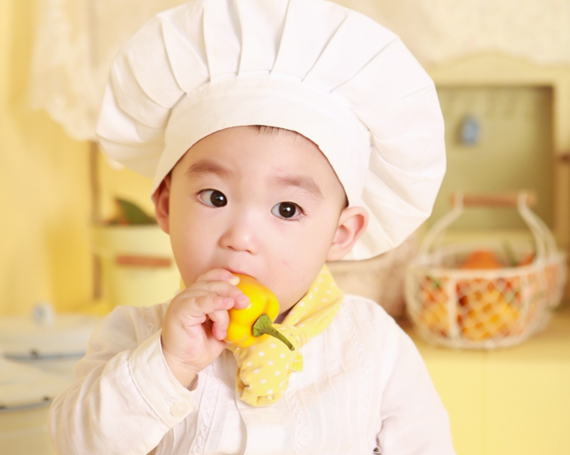Ah, the fussy eater: there is one in every family. The one who you dread taking out for dinner or to family gatherings. The one who tests your patience at every meal time. The one who wakes up one morning and decides that the one food item you thought you could rely on for them to eat, is no longer an option…
Ours was a challenge to say the least. She’d shake her little curls at anything that wasn’t beige in colour or sticky and sweet in taste. A few times, we found her in the bathroom, attempting to flush her greens away along with my chances of having a normal family dinner.
Fortunately, things are different now and she has learned to eat most of what she is given at meal times. These top tips helped us through the fussy eating stage, and from one mum to another, its time to pass them on.
Let them use their hands.
Allow your child to interact with food and eat with their fingers if they want to. Our little one loved this. It may seem like a step backwards but allowing them to have more control over their food will increase the amount of vegetables that actually make it into their mouth. They can also focus all of their attention on consuming the food rather than worrying about how to use utensils like knives and forks. Manners are important but getting the vitamins and minerals they need from vegetables and healthy foods is more important. Once they actually eat the food, you can begin lessons in table etiquette.
Get them involved in the shopping.
Let them help prepare the weekly shopping list. Get them involved in the supermarket locating fruits and vegetables and placing them in the trolley. Try letting them choose their favourite veg which will encourage them to have a positive relationship with healthy food. You can even make it a game, eye-spy style, encouraging your children to look for a certain brightly coloured vegetable.

Let them help in the kitchen
Don't worry, we are not trying to turn them all into tiny Jamie Olivers. However, one way we got our fussy eater to try some veg, was by allowing her to get involved in the preparation. If your little ones spend time and effort preparing food, they will want to taste it. You can even let them choose a meal or two during the week- within reason- you don’t want chicken nuggets three times a week. This will let them know that their opinion matters when it comes to food and give them a little control over what they eat.
Secret veggie pasta sauce
Blend vegetables in tomato sauce for pasta. This is a sneaky one but a very smart way to get your kids to eat vegetables. Peel and boil any vegetables you like. From broccoli to parsnips, from aubergines to kale, anything healthy you can find in your fridge, throw into the pot and boil them up. Make sure you add tomatoes and carrots to get that red colouring. Add few onions and a bit of garlic for flavour. Then grab your blender and go to town. Blend the sauce as much as you think you need to, so that your fussy eater will eat it. In our house we make a big batch every month and freeze little pots of secret pasta sauce, so we can defrost them as needed.

Disguise fish
Fish is very important in our house. My dad always told us that fish goes straight to the brain. However, it's not always easy to get fish into those little tums. A top tip to get your child eating fish is to mix it into potato and make a fish cake. That way your little one is getting all the benefits of eating fish without even realising it.
Once they unwittingly get used to the taste of fish you can bring it out of hiding. Make sure you also serve something they really like next to the fish, such as mashed potato or homemade chips. If you are dealing with a pasta-only eater, try a salmon or tuna pasta. Pairing fish with something they love will help them associate fish with the food they really enjoy, and eventually this meal will be a winner for both mum and her fussy eater.
Remove all distractions and have a sit-down family dinner
When my fussy eater was at her fussiest, it was easy to stick on the TV and distract her while we shovelled food into her mouth. However, she soon realised what was up, and that if she kept her mouth buttoned closed as she watched, we would finally give up and stick on the plain pasta. Then my mother suggested to remove all distractions and simply focus on having a family dinner. Everyone ate the same thing and chatted around the table. As she watched the others eat, she automatically began to do the same. As usual, my mum was right and eliminating all distractions allowed her to focus on her meal. It also meant that we could sit down to a proper family dinner again without having to worry about sneaking spoons of food into her reluctant little mouth.
Haliborange Multi-vits to boost your child’s immune system
Despite these strategies, there can be moments where nothing works and it can be difficult to ensure our kids get all the nutrients they need from their diet alone. Vitamins and mineral supplements can help bridge the gap. That’s why we trust Haliborange, Ireland’s No. 1 kid’s vitamins brand.
It’s important to remember that in the first 12 years of life, nutritional requirements are particularly high. That’s why Haliborange offer products tailored for children aged 1 month to 12 years+. For kids 3-12 years, they have specially formulated vitamins to help support health and wellbeing. These are available in different formats like liquids, softies and chewys, so there is an option to meet every family’s needs. Taste is key to ensure that kids take supplements, and Haliborange has a range of softies in delicious flavours kids love.
Good luck with your fussy eater, mums and dads. You’re doing great!







